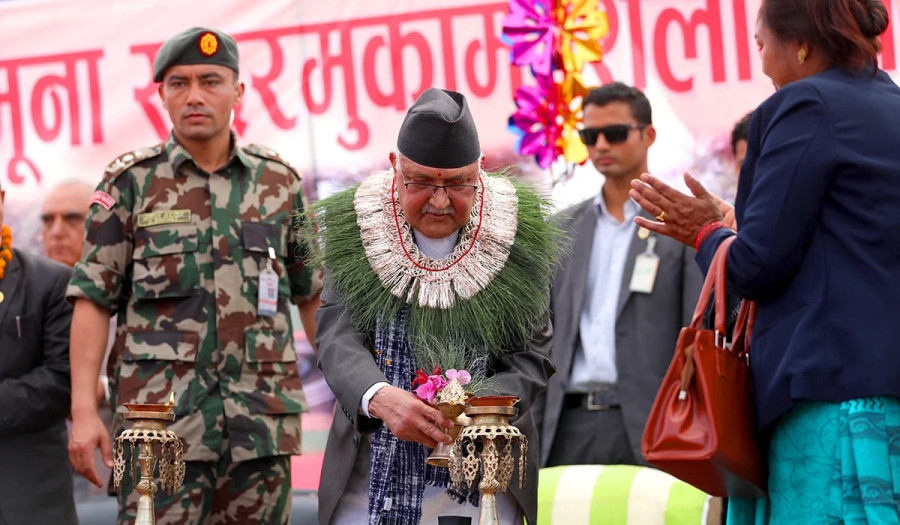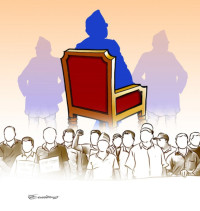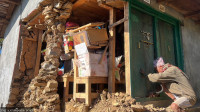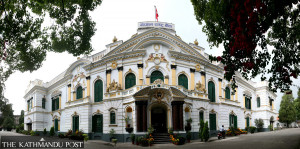Columns
Saffronisation of the body politic
Oli wants to be the republican inheritor of Hindu rule, by mingling royalist yellow with Marxist-Leninist red.
CK Lal
The constitutional free fall in the country continues unabated. Supremo KP Sharma Oli initiated the free-for-all as soon as he took the reins of government in February 2018 by concentrating unprecedented authority in his secretariat. Instructions began to flow directly to the senior administrators. Whenever a cabinet colleague dared to assert, the Prime Minister reshuffled them like a pack of cards.
Oli had already packed various constitutional organs with his loyalists during his first term in office in 2015 and through his party's share of the division of spoils with the Nepali Congress. When it appeared that the Parliament may come into the way of his autocratic ambitions, he fast-tracked two ordinances—one to split the political party and another to use the Constitutional Council at will. A controversial attempt to 'abduct' an MP was also made to strengthen the legislative position of the chief executive.
Once Supremo Sharma Oli realised that even a subservient Parliament could come into the way of his executive unruliness, he started to undermine its sovereignty. His recommendation for the abrupt dissolution of the House in December 2020 was meant to subvert the constitution and prevent Parliament from electing a new leader. The Constitutional Bench of the Supreme Court recognised the conceit and annulled the presidential order of dissolving the House.
Oli's political recklessness has resulted in the erosion of the supremacy of Parliament. The Supreme Court used its supreme authority to quash the unification of the Communist Party of Nepal-Unified Marxist Leninist and the Communist Party of Nepal (Maoist Centre). Calculations of aspirants of premiership turned topsy-turvy thereafter.
The combustible combination of unbridled ambition and resentful recklessness made Oli take the oath of office for the second time in his second term and have Parliament dissolved once again in a suspense-filled midnight drama.
According to some parliamentarians that had gone to the Presidential Palace to support the claim of the leader of the opposition, Sher Bahadur Deuba, for the leadership of the House, their delegation was forced to wait at the main gate and made to stand in the hallway to make their case once allowed inside. Such a humiliation of the leader of the opposition along with over a hundred MPs was unprecedented in parliamentary history.
The constitutionality of the political mayhem, apparently wrought by rival claimants of leadership, has ended up in the Supreme Court once again.
Harmonious disarray
After dissolving the House twice at the recommendation of an embattled prime minister, President Bidhya Devi Bhandari probably feels that it's now her turn to assert the authority of the Head of State. Her office told the Supreme Court that the President holds the right to determine whether the prime minister had the support of the House and the judiciary had no authority to overturn her decision.
With the exception of the Katuwal Kanda when President Ram Baran Yadav had overturned Prime Minister Pushpa Kamal Dahal's decision to dismiss the army chief for insubordination, the office of the Head of State in Nepal has adhered to the parliamentary tradition and confined itself to ceremonial duties.
It seems President Bhandari desires a greater role in the power vacuum that has resulted from the repeated dissolution of the House. When she has to fast track ordinances that have little chance of parliamentary endorsement within the stipulated timeframe, perhaps she is correct in taking the initiative of writing routine request letters to foreign heads of state and chief executives.
The Supreme Court asserts its supremacy whenever it deems fit to overrule executive decisions. It reinstated Parliament. Its decision annulled the unification of two political parties. It has stayed the citizenship ordinance. Meanwhile, hearings on several other ordinances, including on the all-important constitutional council amendment, is still awaited.
On the face of it, the legal decomposition, the diplomatic decay, the political putrefaction and the administrative corrosion in the middle of a pandemic appear baffling: how can every organ of the state become simultaneously dysfunctional? However, those in the know hold that there is a method in the madness of constitutional organs acting at seemingly cross-purposes.
Subversion of the constitutional order and institutionalisation of Hindutva polity appears to be the common goal of all important players. The Supremo wants constitutional constraints out of the way to remain prime minister for life and is ready to tear the statute that has helped him reach where he now stands. He is ready to advance the 'saffronisation' agenda and retreat from the position of weaponisation of the goat-tailed map.
Ever since an extra-constitutional arrangement elevated the chief justice to the post of prime minister, ambitions of former and serving judges have become more material than moral. After all, it's humane to wish for political authority when the very existence of the legislature and the legitimacy of the executive depends upon the decisions of the judiciary.
Once de-politicisation of governance takes place, de-secularisation will automatically follow. Religion is the default position of all 'nationalist' rulers in every traditional society.
Hindu homeland
The idea of secularism is a novelty in Nepal and it made into the political vocabulary fairly recently. The 'world's only Hindu' description stayed with the name for as long as the country was a kingdom.
Ideologically speaking, Marxist, Leninist and Maoists are atheists by definition and they hardly need the bourgeois respectability of secularity. The comfortable class is more comfortable with freedom of religion than with the idea of secularism.
Even though only in name, secularism made its way into the controversial constitution to restore the dignity of Dalits, Muslims and traditionally beef-eating Janajatis. The concept was promptly undermined by authorising the state to protect and promote sanatan traditions, which is a politically correct term for 'Asal Hindustan' of King Prithvi's imagination.
After seizing power through the Kot Massacre, Jung Bahadur strengthened the 'Hinduisation' project of Gorkhalis by codifying the caste hierarchy and odious practices of the time through the Muluki Ain (laws of the land), practising patia (atonement) rituals and patronising priests and precepts.
The deep religiosity of Ranaudip Singh couldn't protect him from being killed by his less religious nephews, but the main beneficiary of the coup d'état was Chandra Shamsher. During his long reign, Chandra cultivated Hindu holy-men to keep the mandate of heaven upon himself and engaged pandits of Varanasi to advance his interests.
Mahendra followed in the footsteps of his illustrious predecessors and advanced the Hindutva agenda to the applause of the Rashtriya Swayamsevak Sangh. Through a network of seers, sages and royal relatives spread out in the Indian subcontinent, the Shah-Rana clan has always maintained close links to militant elements of Hindutva politics.
Supremo Sharma Oli wants to be the republican inheritor of Hindu rulers by mingling royalist yellow with Marxist-Leninist red to use the saffronisation template in Nepal. The consequences for the inherently plural and diverse society of the country could be grave and unsettling, but the ruling elite seems to be ready to go to any extent to advance Khas-Arya hegemony.
In Mahantha Thakur and his followers, the Hindutva lobby has succeeded in enlisting Madhesi collaborators for the ethnicisation of the Hindu religion. Even if Supremo Sharma Oli loses one more battle, he is winning the war of dividing Nepal forever.




 9.12°C Kathmandu
9.12°C Kathmandu















